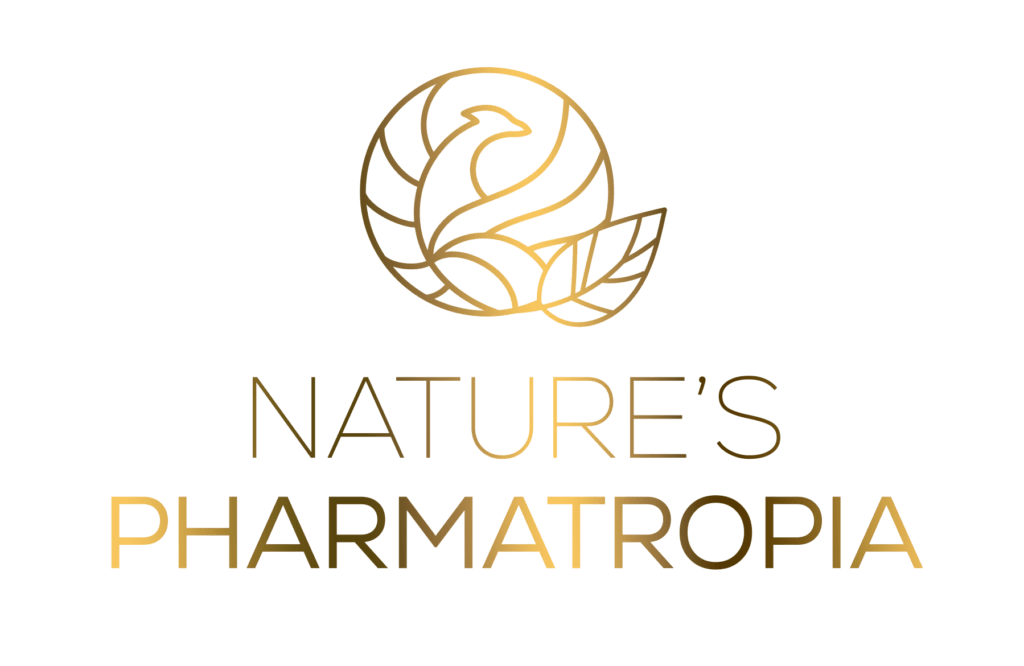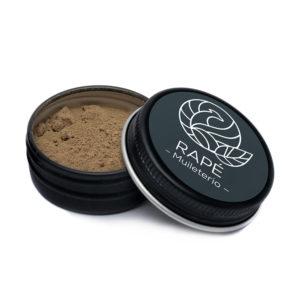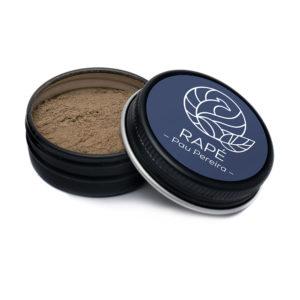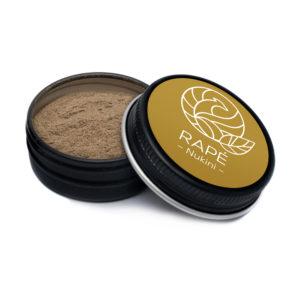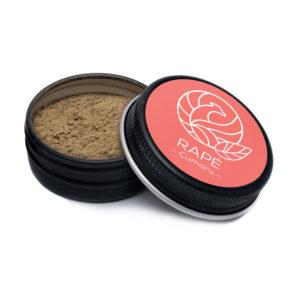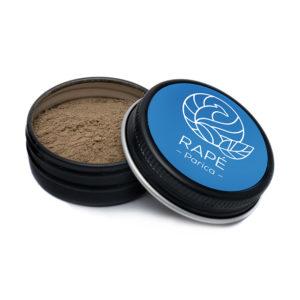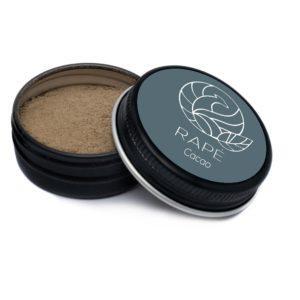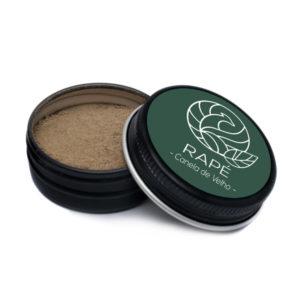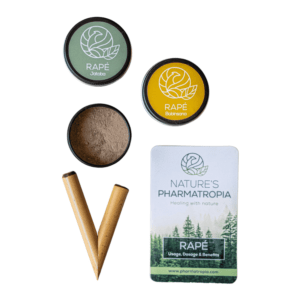Rapé, the Amazon’s Sacred Snuff
Rapé is a Mapacho-based snuff used in South American shamanism. It is also known as rapeh, hapé, and hapay (the spelling that most closely corresponds to the English pronunciation). It is a powdered plant mixture, usually containing Mapacho and tree ash, that is insufflated (blown into the nose) as a sacred medicine. It is frequently combined with ceremonial plant medicines such as ayahuasca.
Rapé is ingested through a kuripe or tepi, which blows it directly into the nostrils. The experience can be intense and visceral, and it is important in Amazonian shamanism.
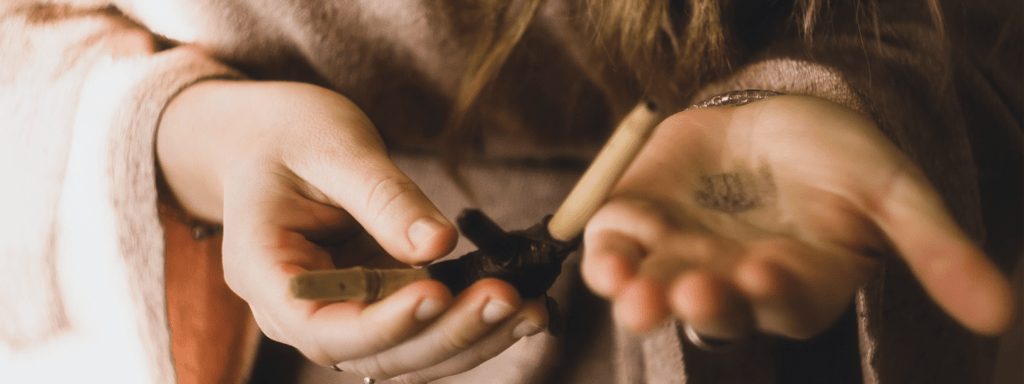
The History
Tabacco has been used medicinally in the Americas for thousands of years, derived from Nicotiana tabacum and Nicotiana rustica. Throughout its history, it has been both smoked and snuffed. The name ” Tabacco ” is most likely derived from the pipe through which indigenous Americans smoked it (tabago).
It has been used to treat illnesses and prevent disease by indigenous peoples in the Americas since its inception. It also has a long history of recreational use.
When Westerners discovered Rapé insufflation (snuffing) in the 1500s, it was a common practice throughout the Americas. It quickly spread across Europe and gained popularity among the aristocracy, though the Pope outlawed its use in 1624 because the pleasurable sensation felt while sneezing (after insufflation) was thought to be too similar to sexual ecstasy.
In Europe, the use of Rapé snuff eventually died out in the nineteenth century, as chewing and smoking Tabacco became more popular. Tabacco snuffs, particularly rapé blends, remain important staples of shamanic cultures in the Amazon.
Rapé is a type of snuff that can be found throughout the Amazon. It typically contains Nicotiana rustica (Mapacho), as well as other plant admixtures. Almost all rapé mixtures contain Mapacho, though there are some exceptions, such as the Apurina’s green rape (Nene).
Modern Application
Rapé is now practiced by many Amazonian cultures, including the Huni Kuin, Yawanawa, Katukina, Apurina, Nukini, and Kuntanawa. It is an essential component of many Amazonian tribal communities, used both socially and in healing or ceremonial contexts.
Mapacho is not only used in these cultures, but it is also smoked, drunk as a juice (extract), used as a salve, or included in ayahuasca recipes. It is used to cleanse, protect, and expel negative energies from objects or people.
Mapacho is a plant medicine as revered as any other in Amazonian traditions; shamans train for years, fasting with it and becoming acquainted with the spirit by journeying repeatedly into its realms.
Rapé has begun to enter Western culture, following in the footsteps of other indigenous medicines such as ayahuasca. As Westerners’ demand for rapé has grown, indigenous groups are establishing relationships with Western suppliers to ensure they can provide authentic recipes while protecting their cultural identity and ensuring the sustainability of the plants involved.

Rape’s Effects
Rapé is a visceral experience because plant powder is literally blown into your sinuses. It can be jarring, and getting past the initial shock without the desire to sneeze, cough, or vomit can take some practice.
The Mapacho in rapé will hit you hard and have an immediate stimulating effect, which is sometimes referred to as a “jolt.” This stimulation will enhance and expand the other medicines in the rapé mixture, as well as any other plant medicines you have taken prior to the rapé application.
It may take some getting used to, but you should be able to get past the initial physical discomfort of having powder in your sinuses and begin to focus more on the effects of it after a while. You can use the stimulation to connect with the grandfather spirit of the Mapacho plant and allow it to collaborate with the other plant medicines in your system to bring out even more healing benefits.
Many people report that taking rapé has helped them extract new meaning and power from other plant medicines that they were unaware existed.
The Therapeutic Potential
Rapé has unquestionably been used for medicinal purposes for many generations. Its shamanic use allows healers to explore the shifting energies within their patients, restore spiritual imbalances, and remove negative energies in addition to treating physical issues.
Purgative properties are well established; after a dose, people frequently feel the need to vomit, defecate, or clear their sinuses (vomiting and diarrhea purging is unlikely when self-administering). This can be used to help cleanse the body of parasites and contribute to a general sense of detoxification.
There hasn’t been much Western research into the medicinal properties of rapé, which is complicated by the fact that different blends use different plants and thus have different pharmacology and healing potential. However, we do know a little bit about the Mapacho plant’s medicinal potential.
While there are some risks to smoking, which we will discuss later, we also know that nicotine can be beneficial. To begin with, it is a powerful pain reliever, which is why Mapacho salves and topical juices have been used throughout history. Nicotine is also being investigated as a treatment for Parkinson’s disease , as well as disorders such as depression and ADHD. However, no Western studies on the specific medicinal properties of rapé snuffs have been conducted.
Furthermore, while the Mapacho plant contains compounds with antifungal and antimicrobial properties, this is primarily for the purpose of protecting it from disease (which is not always successful!). While some have attempted to make this connection, the idea that these compounds could also protect humans is far-fetched.
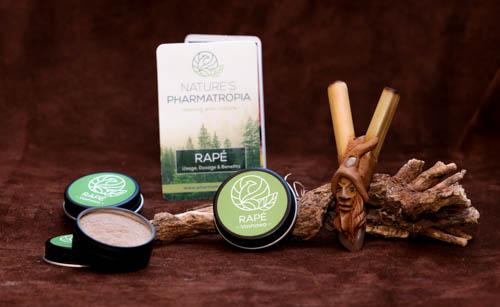
The Science of Pharmacology
Rapé pharmacology is determined by the ingredients in the mixture. Although the main ingredient in most rapé blends is Mapacho, the other plants can have a significant impact on the pharmacology of the mixture.
The pharmacology of nicotine is well-studied: it activates dopamine, a reward neurotransmitter in the brain, and also causes the release of opioids. It is a strong stimulant that causes the release of adrenaline and has well-established addictive properties.
Nicotine repels herbivores , preventing the Mapacho plant from being eaten. The Mapacho plant contains antimicrobial and antiviral molecules that protect it, but it’s unlikely these molecules would have any protective effects in humans.
Although nicotine has no negative interactions with common plant medicines such as ayahuasca, the stimulation (and purgative effects) of ceremonial medicines may enhance their psychoactive effects.
The other plants in rapé blends will obviously have an effect on the pharmacology of the dose and may interact with nicotine. The admixtures in rapé blends, on the other hand, will have been carefully selected over hundreds of years of shamanic use and are unlikely to be dangerous.
Is Rapé Safe?
As previously stated, rapé has many traditional medicinal properties, and Tobacco products, on the other hand, all carry some risk, as all Tabaco, especially when burning is carcinogenic to some extent.
Research suggests that taking Mapacho snuff can be slightly safer than smoking tabaco . However, most studies compare Western cigarettes to Western snuffs, both of which contain harmful additives and chemicals. In short, we don’t know how rapé snuffs compare to other tabaco products in terms of harm.
However, we do know that it contains the usual carcinogenic substances found in tabaco plants. Mapacho is burned in many rapé blends, which increases the carcinogenic properties of the plant. As a result, it’s reasonable to assume that, while rapé may be less harmful than smoking Western cigarettes or using Western snuff, it will still increase your risk of cancer if you use it frequently.
Some may argue that because cancer is not a major issue in indigenous populations who use rapé, the risk cannot be high. However, in the absence of large-scale studies on cancer rates in indigenous populations, we cannot yet reach this conclusion.
We advise you to be aware that using any tabaco product increases your risk of cancer, and you should avoid using it if you are pregnant.
Addiction is another danger of rapé. Nicotine is a addictive substance that can lead to addiction. If you are concerned about addiction, we recommend using it as sacred plant medicine rather than recreationally.
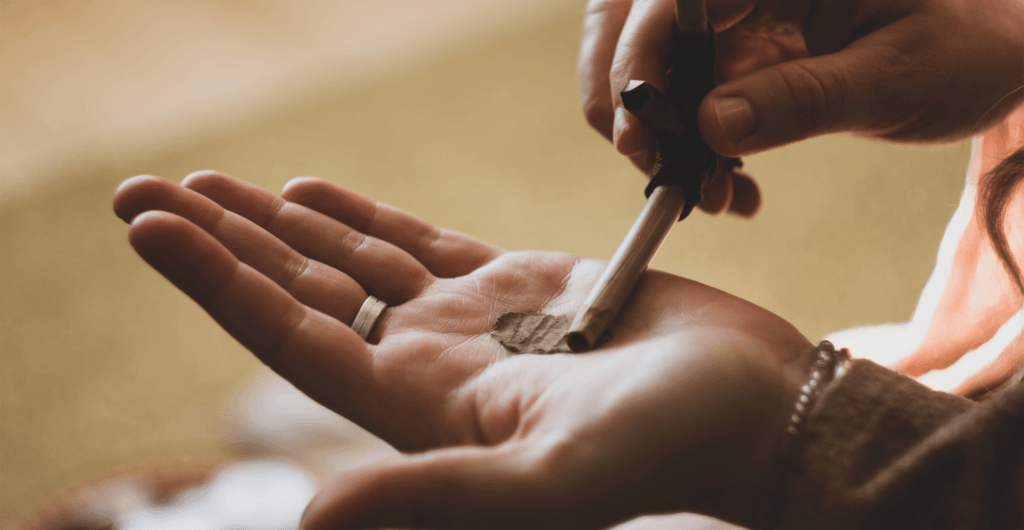
How to Use It
There are two ways to consume rapé. You can either self-administer it with a kuripe or have someone else blow it into your nostrils with a standard tepi pipe. When a trained shaman administers rapé, the act is known as a soplada; this term also refers to a special healing energy that is transmitted through the shaman’s breath, in addition to the power of the rapé. Always use decrement when allowing someone else to blow you rape.
Self-administration with a Kuripe
To begin, you’ll need a kuripe, which is a specialized pipe that allows you to blow rapé into your own nose. It’s a V-shaped pipe that allows you to put your rapé at one end, insert it into your nostril, and blow through the other. It takes some practice to master the art of blowing while also closing your throat to prevent coughing, and you must make sure you get a kuripe that fits you.
When you self-administer rapé with a kuripe, you’re foregoing the expert knowledge of a shaman, who can accurately gauge your dose and ensure you get the most benefit out of rapé. However, if there are no experienced shamans nearby or if you want to use it in your daily life, self-administering can be useful.
To use a kuripe, place your rapé dose in the nostril end of the pipe. If you’re just starting out, this will be a pea-sized amount (you can go up from there once you get more comfortable). Before you begin, ground yourself by setting an intention and performing any prayers or chants that can help you bring your consciousness into the present moment.
When you’re ready, take a deep breath and place the mouth end of the kuripe in your mouth and the nostril end (with the rapé) in your nostril. Lean forward and forcefully blow the rapé into your nose. Close your sinuses as if you were about to dive into the water, and then resist the urge to spit, cough, sneeze, or vomit for as long as you can. Allow it to do its work while you enjoy the rush of sensation.
Once the experience has subsided, re-ground yourself and load up your second dose, then repeat the process with your other nostril. Leaning forward afterward can help to reduce the unpleasant “backdrip” that may occur as the excess powder enters your throat. Once the experience has passed, rinse your nostrils thoroughly.
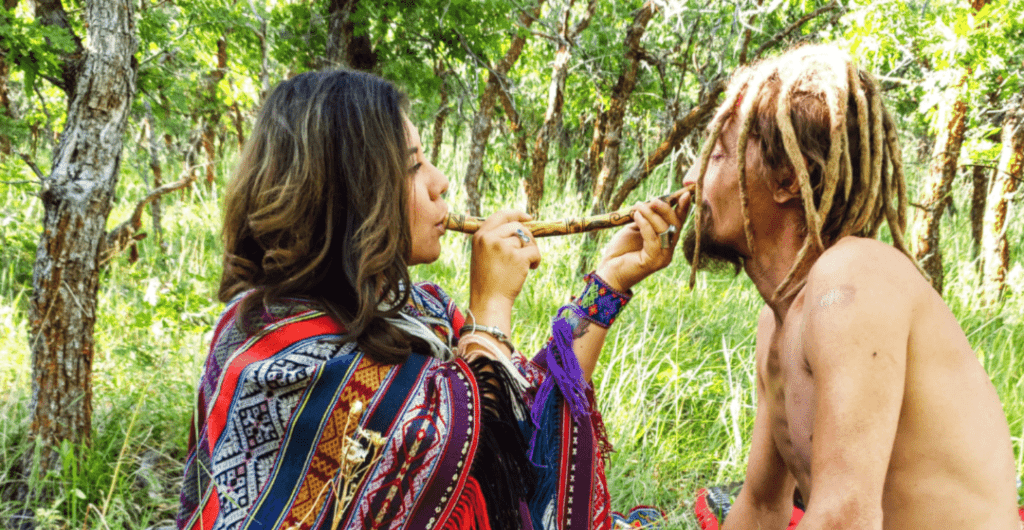
Receiving a soplada with a Tepi
Always use discernment when allowing someone else to blow you rape. Its is best to seek out a shaman to provide you with a soplada of rapé, the powder can be administered by almost anyone. While a shaman will provide additional knowledge and understanding of how to balance the energies of the plant, it does not require special skill to blow the powder up someone else’s nose.
A tepi, which is a simple pipe, is required for a soplada. Like the kuripe, you simply load a dose of rapé into the longer nostril end, insert it into the recipient’s nostril, and blow into the shorter mouth end.
As with any plant medicine, you should spend some time beforehand grounding yourself and setting an intention. If you’re with a good shaman, they’ll probably perform some rituals or preparations of their own and spend some time connecting with you before administering the dose.
If you’re getting a dose from someone who isn’t a shaman, start slowly with a pea-sized amount in each nostril. Otherwise, the shaman will determine an appropriate dose for you.
When the blower is about to start, close off the very back of your sinuses as if you were about to dive into the water. After the initial shock of the jolt has passed, try to feel into the rapé. You may feel the need to cough, sneeze, or vomit; try to lean forward to keep the powder from falling back into your throat.
After the effects of the first dose have worn off, your shaman will load another dose and blow it into your opposite nostril. When the ceremony is over, clean out your nostrils after both doses and once you have regained presence.
Rape Ceremony
Although rapé is a potent plant medicine in its own right, it is frequently used before, during, or after ceremonies involving other plant medicines. Because of its properties, it can be used to cleanse and purge participants prior to the use of powerful plant medicines like ayahuasca, allowing you to enter the ceremony more mentally and physically unburdened. It can also be used during the ceremony to initiate purging or to boost the potency of the plant medicine in question. Rapé can also be used after the ceremony to help mark the end of the ceremony and cement any healing and transformation that has occurred.
If you attend an indigenous ayahuasca ceremony where rapé is used, you might be surprised to see people taking it almost constantly throughout the night. Rapé is a part of Amazonian culture, so this is normal for indigenous people.
Nonetheless, it is a potent plant medicine and not just a supplement to ayahuasca or other transformative medicines. It is thought to facilitate a sacred communion with nature and a way to connect with the plant spirits included in the rapé blend. Learning to communicate with plants in rapé is similar to learning to communicate with any other sacred plant medicine. It is subtle, challenging, and ultimately transformative and healing.
What are the best blends?
Every Amazonian culture that uses rapé has a unique blend that has been passed down through generations of shamanic expertise. Blends are typically designed for a variety of purposes, including spiritual exploration and specific healing applications.
Rapé’s effects may even differ from batch to batch due to the varying potency of the plants in each blend. As a result, no two doses will be the same.
At Nature’s Pharmatropia we are very specific on not only the quality of the rape we offer, but also on the energy of the ceremony it was made under. We pride ourself on the clean high frequency energy of the rape we provide.
The Huni Kuin create blends that are typically heavy on Mapacho. They frequently contain the ashes of the Murici tree, which is thought to have a joyful spirit and can help with fatigue. Rapé blends made with ashes from the Cumaru tree, which is one of the Amazon’s longest-living trees and has the hardest wood. Cumaru ash is thought to provide spiritual protection; however, it contains coumarin, which can be toxic to the liver in large amounts, so use with caution.
The Kuntanawa make very fragrant rapé blends that contain a variety of traditional herbs with medicinal properties. Chamba, Anador, and Alfavaca da Mata are among these plants. They are said to aid in the combat of negative energies known as panema in traditional lore.
The Nukini are a tribe whose women are in charge of creating rapé blends. As a result, their combinations are said to impart feminine energy. Mapacho and the ashes of the Parika and Mulatinha plants, which are said to help with relaxation and add power to the blend, are used in the most common blends.
The Yawanawa call rapé rume and make strong blends with Mapacho and ash from the Tsunu tree. This is a potent blend that can cause sweating and watery eyes.
In addition to these traditional blends, many tribes produce rapé that is appealing to a Western audience. You may come across blends that include admixtures such as cacao, eucalyptus, chaliponga, and other plants that Western plant medicine enthusiasts are familiar with.
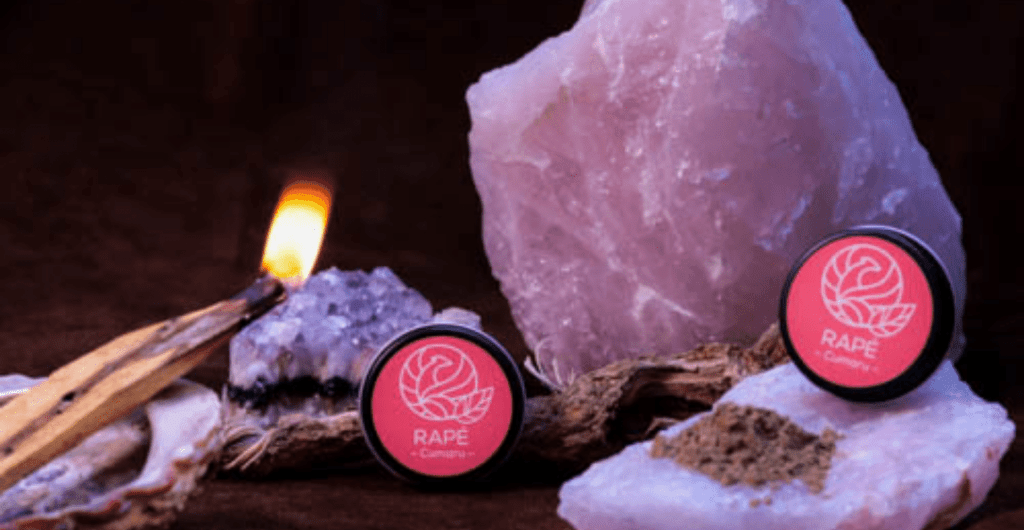
Rapé and depression
Not only does rape work on the dopamine that is closely related to depression. Depression is associated with emotional wounds that we have concealed and/or failed to recognize. These wounds have power over us only because we are unaware of them; they vanish the moment we notice them, work with them, and let them go.
Rapé is a tool for reaching deep within your soul to heal, to release judgments, guilt, resentment, or whatever the current wound is that prevents you from living fully.
Many times, these wounds are extremely painful, or we are emotionally attached to them and refuse to let them go. This is the point at which we must make a conscious decision about whether we want to continue carrying them or move forward; whatever decision we make, our lives will change. We will do it consciously, which will empower us in front of it, change our appearance, and allow us to live from a different perspective.
How to get started
Rapé is a medicine that can be taken quietly and alone, with complete peace of mind. We recommend that you begin with less and work your way up, introducing yourself to the spirit of rapé, getting to know it and letting it get to know you, experimenting with different types of breathing, and following your own rhythm. As you use it more clearly, your intuition will speak to you. Work together with it, allow yourself to hear its call, and you will be amazed at the results.
